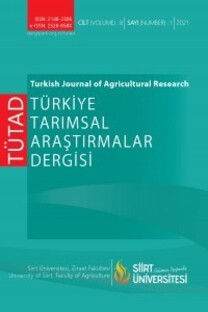Some Orchid Species Fungi Isolated by Different Methods
Some Orchid Species Fungi Isolated by Different Methods
___
- Arditti, J., 1967. Factor affecting the germination of orchid seeds. Bot. Rev., 33:1-97.
- Bernard, N., 1909. Levolution dans la symbiobe. Les orchideés et leurs champingnons commensaux. Ann. Sci. Nat. (Bot.), 9(9): 1-196.
- Burgeff, H., 1936. Die samenkeimung der orchideen. G. Fischer, Jea. 312.
- Chesters, C.G.C., 1949. Concerning fungi inhabiting soil. Trans. Brit. Mycol. Soc., 32:197-216.
- Clements, M.A., Muir, H., Cribb, P.J., 1986. A preliminary report on the symbiotic germination of Europe an terrestrial orchids. Kew. Bull, 41(2): 437- 445.
- Curtis, J.T., 1939. The relation of specificity of orchid mycorrhizal fungi to the problem of symbiosis. Amer. J. Bot., 26: 390-399.
- Çığ, A., 2012. Vanda doğal olarak yetiĢen salep orkidelerinin simbiyotik ve asimbiyotik olarak in vitro ve in vivo ortamlarda çoğaltılması. Doktora tezi, Yüzüncü Yıl Üniversitesi, Fen Bilimleri Enstitüsü, Van.
- Davis, P.H., 1984. Flora of Turkey and the East Aegan Islands. Volume: 8, Edinburg University Press, Great Britain.
- Ekim, T., Koyuncu, M., Vural, M., Duman, H., Aytaç, Z., Adıgüzel, N., 2000. Türkiye Bitkileri Kırmızı Kitabı, Yayın No: 18, Ankara.
- Gezgin, Y., 2004. ÇeĢitli salep (orkide) türlerinde mikoriza oluĢturan fungusların izolasyonu ve tanımlanması ile inokulant olarak kullanım olanaklarının incelenmesi. Yüksek lisans tezi, Ege Üniversitesi, Fen Bilimleri Enstitüsü, İzmir. Hadley, G., 1983. Symbiotic germinati on of orchid seed.The Orchid Review, February, 44-47.
- Harvais, G., Hadley, G., 1967. The relation between host and endophyte in orchid mycorrhiza. New Phytol., 66:205-215.
- Hasenekoğlu, İ., 1991. Toprak Mikro Fungusları. Atatürk Üniversitesi Yayınları, No: 689, Kazım Karabekir Eğitim Fakültesi Yayınları No: 11, Cilt: IV-VI. Erzurum.
- Hayakawa, S., Uetake, Y., Ogoshi, A., 1999. Identification of symbiotic Rhizoctonias from naturally occurring protocorms and roots of Dactylorhiza aristata (Orchidaceae). J. Fac. Agr. Hokkaido Univ., 69(2): 129-141.
- İĢler, S., 2005. Van salebinin menĢei ve Van civarının orkideleri. Doktora tezi, Yüzüncü Yıl Üniversitesi, Fen Bilimleri Enstitüsü, Van.
- Koyuncu, M., DemirkuĢ, N., 2000. Van çevresi geofitleri. XV. Ulusal Biyoloji Kongresi (Uluslararası Katılımlı), 05-09 Eylül 1999, Ankara.
- Madigan, M.T., Martinko, J.M., Parker, J., 2003. BrockBiology of Microorganisms. 10th ed., Prentice Hall Inc., ISBN 0-13-085264-3.
- Masuhara, G., Kimura, S., Katsuya, K., 1988. Seasonal changes in the myccorrhizae of Bletilla striata (Orchidaceae). Trans. Mycol. Soc. Japan., 29:25-31.
- OrtaĢ, İ., 2011. Orkide mikorizasının bitki çimlenmesi ve geliĢimi üzerine etkisi. I. Salep Orkidesi ÇalıĢtayı, 24-25 Mayıs, KahramanmaraĢ, s. 39-64.
- Özkoç, İ., 1991. Serapias vomeracea (Burm fil.) Briq. subsp. laxiflora (Soo) Gölz et. Reinhard ve Orchis laxiflora Lam. (Orchidacea) tohumlarının simbiyotik ve asimbiyotik kültürlerde çimlenme ve geliĢmesi üzerinde araĢtırılması. Doktora tezi, Ondokuz Mayıs Üniversitesi, Fen Bilimleri Enstitüsü, Samsun.
- Papavizas, G.C., Adams, P.B., Lumsden, R.D., Lewis, J.A., Dow, R.L., Ayers, W.A., Kantzes, J.G., 1975. Ecology and epidermiology of Rhizoctonia solani in field soil. Phytopathology, 65: 871-877.
- Roberts, D.L., Herr, L.S., 1979. Superiority of a soil debris isolation method over a beet seed colonization method for assay of Rhizoctonia solani at high soil inoculum densities. Can. L. Microbial, 25: 1110- 1113.
- Sezik, E., 1984. Orkidelerimiz, Türkiyenin Orkideleri. Sandoz Kültür Yayınları, No: 6, 166.
- Vakkasoğlu, F., 1995. Orkidelerde mikorizal fungusların orkide tohumlarının çimlenmesi ve büyümeleri üzerine etkisi. Yüksek lisans tezi, Çukurova Üniversitesi, Fen Bilimleri Enstitüsü, Adana.
- ISSN: 2148-2306
- Yayın Aralığı: 3
- Başlangıç: 2014
- Yayıncı: SİİRT ÜNİVERSİTESİ ZİRAAT FAKÜLTESİ
Sofralık ve Kurutmalık İncir Kalite Kriterleri ve Kaliteyi Etkileyen Faktörler
Arzu GÖÇMEZ, Halil Güner SEFEROĞLU
Antalya'nın Kepez İlçesinde Geleneksel Sera Üretiminin Özellikleri
Uğur GALE, Yüksel TÜZEL, Gölgen Bahar ÖZTEKİN
Agricultural Meteorological Properties of Aras Basin in Turkey
Orhan DENGİZ, İnci DEMİRAĞ TURAN
